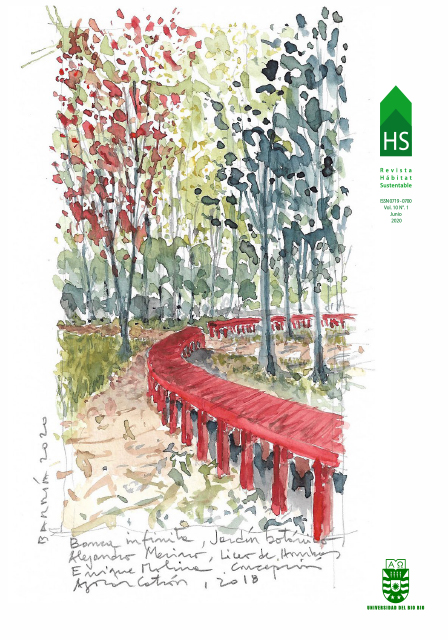Sustainable housing: A discussion on the efficient management of water use in domestic installations. Case study: Santa Fe –Argentina
DOI:
https://doi.org/10.22320/07190700.2020.10.01.06Keywords:
housing, sustainability, efficiency, water, abatement curveAbstract
This work aims to present a critical reflection about the efficiency of water resource management in the case study - City of Santa Fe, Santa Fe (Argentina). Analyzing the role of sanitary installations in optimizing water use as an essential resource. In methodological terms, a three-dimensional analysis is proposed: the city’s water system, the current regulations for surplus management and the water network supply. The author’s prior research projects are recovered to measure typical household consumption, considering two variables: rational water use and consideration of service efficiency technologies. In summary, abatement curves are made to characterize the efficiency in three scenarios. As a discussion, the responsibilities of users, and the praxis of architecture professionals, responsible for conceiving the sustainability of urban housing in Santa Fe, are questioned.
Downloads
References
Bartram, J., Corrales, L., Davison, A., Deere, D., Drury, D., Gordon, B., Howard, G., y Stevens, M. (2009). Manual para el desarrollo de planes de seguridad del agua: metodología pormenorizada
de gestión de riesgos para proveedores de agua de consumo. Ginebra: Organización Mundial de la Salud.
Bello, O., Ballesteros, J., Buitrago, M., González, M. y Velasco, O. (2018). Análisis retrospectivo de las inundaciones: lecciones y recomendaciones. Buenos Aires: CEPAL - ONU.
Calcagno, A., Mendiburo, N., Gaviño Novillo, J.M. (2000). Informe sobre la gestión del agua en Argentina. Buenos Aires: Ed. Global Water Partnership.
Castillo-Ávalos, Y. y Rovira-Pinto, A. (2013). Eficiencia hídrica en la vivienda. Revista Tecnología y ciencias del agua. Volumen 4 (4), pp.159-171.
Cátedra de Instalaciones I, II y III (2018). Cuadernillo bibliográfico de Instalaciones [Apuntes]. Taller Vertical Bellot. FADU. UNL.
Clerc, J., Díaz, M. y Campos, B. (2013). Desarrollo de una metodología para la construcción de curvas de abatimiento de emisiones de GEI incorporando la incertidumbre asociada a las
principales variables de mitigación. Banco Interamericano de Desarrollo.
Delucchi, A. (2016). Acerca del proyecto en arquitectura. Entre la reconstrucción y la invención. Buenos Aires: Ed. Diseño.
Díaz Dorado, M.D. (2008). Instalaciones sanitarias y contra incendios en edificios. Buenos Aires: Ed. Alsina.
Franco, F. (2019). Cuadernillo del Laboratorio de Hidráulica. [Apuntes] Facultad de Ingeniería en Ciencias Hídricas (FICH). Universidad Nacional del Litoral.
Jiménez, A. (1994). Capítulo 1. En H. Garduño y F. Arreguín (Eds.), Uso eficiente del agua (pp. 6-26). Montevideo: UNESCO-ORCYT.
Latour, B. (2017). Cara a cara con el planeta. Una nueva mirada sobre el cambio climático alejada de las posiciones apocalípticas. Buenos Aires: Siglo Veintiuno Editores.
Lemme, J. C. (1973). Instalaciones aplicadas en los edificios. Buenos Aires: Luis y Félix Fossati SRL.
Paoli, C. y Schreider, M. (Eds.). (2000). El Río Paraná en su tramo medio. (Vol. 1). Santa Fe: Centro de Publicaciones UNL.
Sánchez, L.D. y Sánchez A. (2004). Uso eficiente del agua. Ponencias sobre una perspectiva general temática (TOP). Instituto de Investigación y Desarrollo en Agua Potable, Saneamiento Básico y Conservación del Recurso Hídrico (CINARA). International Water and Sanitation Centre (IRC).
Downloads
Published
How to Cite
Issue
Section
License
The content of articles which are published in each edition of Habitat Sustentable, is the exclusive responsibility of the author(s) and does not necessarily represent the thinking or compromise the opinion of University of the Bio-Bio.
The author(s) conserve their copyright and guarantee to the journal, the right of first publication of their work. This will simultaneously be subject to the Creative Commons Recognition License CC BY-SA, which allows others to share-copy, transform or create new materials from this work for non-commercial purposes, as long as they recognize authorship and the first publication in this journal, and its new creations are under a license with the same terms.











 Scientific Information Program/Concurso Fondos de Publicación de Revistas Científicas 2018/ Proyecto Mejoramiento de Visibilidad de Revistas UBB (Código:FP180007).
Scientific Information Program/Concurso Fondos de Publicación de Revistas Científicas 2018/ Proyecto Mejoramiento de Visibilidad de Revistas UBB (Código:FP180007).





